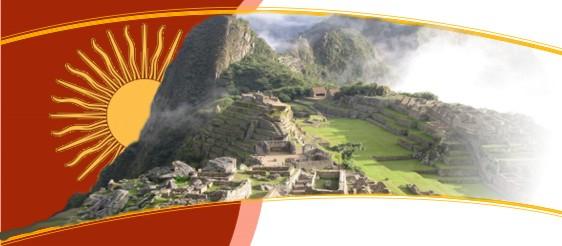|
LOCATION
Altitude
Distance
Population
|
2,230 meters a.s.l.
1,020 km. from Lima.
180 km. from Colca
Valle. 400 km. from Tacna.
619,156 inhabitants
(city). |
GETTING
THERE
A branch the South
Pan-American road leads up from the coast to Arequipa connecting
it with Lima and Tacna. There are 1,020 krn (632 miles) between
Arequipa and Lima and 400 km (248 miles) between Arequipa and Tacna.
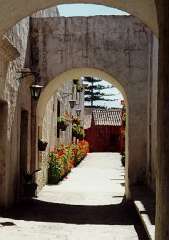 |
By air, there are daily 1
-hour flights from Lima to Arequipa, 30-minute flights
from Cusco, and 20-minute flights from Tacna or Juliaca.
The trip from Puno to
Arequipa by the South Railroad takes 10 hours, leaving on
Mondays, Wednesdays and Fridays. Arequipa is the capital
of the Province, Department and Region of the same name.
It is located at Z230 meters (7,314 feet) a.s.l. it is
the second largest city of Peru. One of Its main
attractions is the fact that Arequipa has probably the
nicest weather of Peru with an average of 300 sunny days
a year. The city keeps its ancient architectural
treasures, but also shows a modern side with many
luxurious hotels and casinos. Arequipa gives tourists the
opportunity to spend a pleasant time in the city and its
outskirts. It is also the departing point for wider
circuits. |
|
Once in the city, the
Plaza de Armas, the 'La Compañia de Jesus' church, which
has cloisters with ashlar (volcanic white stone or
'sillar") arcades, and the renowned Santa Catalina
Convent should not be missed. On the outskirts of: the
city some districts stand out because of their beauty,
like Cayma, which temple was built in 1730, or Yanahuara,
which belvedere offers a great view of the city
surrounded by volcanoes, such as Cachani, 1,076 meters
(3,529 feet) a.s.l.
Also important are the
Yura Chapel, the San Lazaro quarter the Sabandía Mill
and the Añazhuayco quarries, from where the ashlar
('sillar') is extracted. Arequipa is known as 'La Ciudad
Blanca" (White City) because of the color of its
ashlar buildings. |
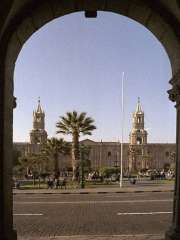 |
MEJIA
LAGOONS
The Mejia Lagoons National
Sanctuary is located on the coast of Arequipa, near the mouth of
the Tambo river, 20 km (12.4 miles) south of the port of Mollendo
and 150 krn (93 miles) from the city.
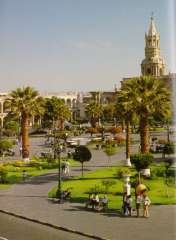 |
It is an isolated
ecosystem and the only vestige, between the north of
Chile and Pisco, of the ancient flooded lands that were
part of the American coast, drained for agriculture for
centuries. In spite of being located at sea level and 170
S latitude, the annual average temperature in the Mejía
Lagoons is usually 18º C (64.40 F), under the effect of
the Peruvian (Humboldt) warm stream.
The lagoons are
separated from the ocean by a large fringe of beaches and
sandy pits. Within the protected area (690 hectares/1,704
acres), several habitats are grouped, including lagoons
of different degrees of salinity, salt marsh, reed
patches, salt mines and wild grass that form a complex
ecosystem. This particularly valuable scenario homes 157
bird species, of which 72 are residents, 62 are regular
visitors and 24 sporadic visitors.
Conservationist and
investigation efforts are being made today to entirely
preserve this natural treasure. |
AGUADA
BLANCA AND SALINAS
Behind the Misti volcano, as
seen from the city, over an extensive plain at 4,000 meters
(13,120 feet) a.s.l. is the Aguada Blanca dam, declared a
National Reserve. It is a rather shallow and artificial lake
originated by the Blanco river containment. A little to the
south, behind the Pichu Pichu peak, is an even larger lagoon
called Salinas. These lagoons are a place for resting and nesting
for a large population of birds like the colorful flamingos.
There is a strong migratory relationship between these birds and
the ones from Mejía, 180 km (111.6 miles) from Salinas.
PAMPA
CAÑAHUAS
Located at the Aguada Blanca
National Reserve, behind the Chachani peak. At about 4,000 meters
(13,120 feet) a.s.I. this larger plain represents one of the best
habitats for the protection of vicuñas. a Peruvian camelid,
internationally known for its fine fleece. In Pampa Cañahuas,
these animals can be seen running completely free and, therefore,
without the shyness and apathy that seems to characterize them
under captivity.
THE
COLCA VALLEY
To the north of Arequipa is the
higher course of the Colca river valley which deep canyon is
renowned among rafters. The section previous to the canyon
consists of an encased valley that runs from east to west,
beginning in the cold puna and running down to warmer regions,
showing its great scenic beauty and cultural attractiveness.
COLCAS
One of the survival skills of
the ancient Colca people was the ability to store large amounts
of grain for hard times the warehouses, known as 'colcas', gave
name to the valley. In the 'cool' caves of Pumunuta, it is
possible to see circular colcas a meter (3.28 feet) in diameter,
mad of mud and straw.
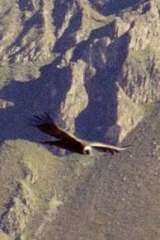 |
CRUZ
DEL CONDOR
Usually, in
such a deep valley, the rising winds are surprisingly
strong which big condors take advantage of to soar into
the sky easily.
Between Maca and
Cabanaconde, where winds are even stronger, is the Cruz
del Condor, an observation point, perfect for watching
the condors while they fly majestically. |
RAFTING
ALONG THE COLCA-MAJES RIVER
From December to March, expert
and trained rafters can go along the high and middle section of
the river, explored by the 1979 Polish expeditions. It includes
very difficult and isolated rapids, as the towns are far from the
torrent. Although the low section may be ran over in rubber
rafts, only expert people, trained in kayac rafting can do it in
the canyon sections.
The name of the Colca river
changes as it flows down to the Pacific ocean, Past the canyon;
its name is Majes. Here, there are more chances for tourists to
go in rubber rafts. The chances of finding shelters and access
ways are better. Although its navigable section (Andamayo-Aplao
river) does not have long rapids, the beauty of landscape and the
clean river course allows enjoying the comfortable trip. The area
is open year round to visitors.
ETHNIC
RICHNESS
An ethnic group,
bearer of ancient and still strong traditions, has dwelled the
valley for more than 2,000 years. They are the Collaguas who
arrived to the Colca valley from the high regions and seem to be
descendants of the Aymaras because of their language and customs.
Even under the Inca dominion, they kept themselves relatively
Independent, and preserved their own traditions. It is sold that
the supreme Inca Mayta Capac married a Collagua princess in order
to formalize the conquest of the valley, and he built for her an
elegant country house made of copper, near Sibayo.
PETROGLYPS
The early settlers of the
valley left their own peculiar trace in petroglyphs such as
Sumbay and Toro Muerto. Dancers with bizarre headdresses,
different mammals, condors, and lines of unbreakable codes
encompass the repertory of vast figures.
CHURCHES
There are almost 20
towns along the valley, which people preserve the ethnic richness
of their past more than any other region of the country. The main
ones are Chivay, Cabanaconde, Huambo, Maca, Achoma, Yunque, Larl
and Coporaque, all very religious towns, whose Catholic faith
also keeps alive pre-Columbian elements. Each town has its own
church, bearer of its Hispanic and an example of architectural
sobriety and purity based on the ashlar stone.
VALLEY OF THE
VOLCANOES
Entering the -so called-
'Valley of the Volcanoes" of Andagua means going back
several geological eras to witness some outstanding phenomena
that only happen in two places In the world: the Canary
Islands and In this Arequipa valley.
|
The Andagua river valley
runs along the foothill of the great Coropuna volcano,
the highest in Peru and the tenth highest in South
America. Geothermal activity In this area has given birth
to about 80 volcanoes, all of them extinct which give
this area a moonlike aspect. Later, the Andagua river
disappears in a 17 km (10.5 miles) stretch, running under
the ground between the Chachas and the Mamacocho lagoons
before flowing into the Colca. Andagua can be reached
only by highway from the west. |
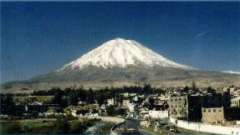 |
HOT
SPRINGS
Because of the
volcanic nature of the region, there is hot springs in different
areas of the valley. The main ones are Yunque, Chivay, Callalli,
La Calera, Huancarama, Yura and Jesus. Furthermore, these hot
springs are frequently related to 'puquiales", natural
sources of cold, extremely pure and 100% potable water.
Spectacular airplane flights are
available allowing a unique and extraordinary view of the main
attractions of Colca, that can only be seen from the air. There
are landing strips in Huambo (in the canyon), Orcopampa (near the
Volcano Valley), Coporaque (the high part of the valley),
Tiabaya, near Arequipa and also from the city airport.
|
